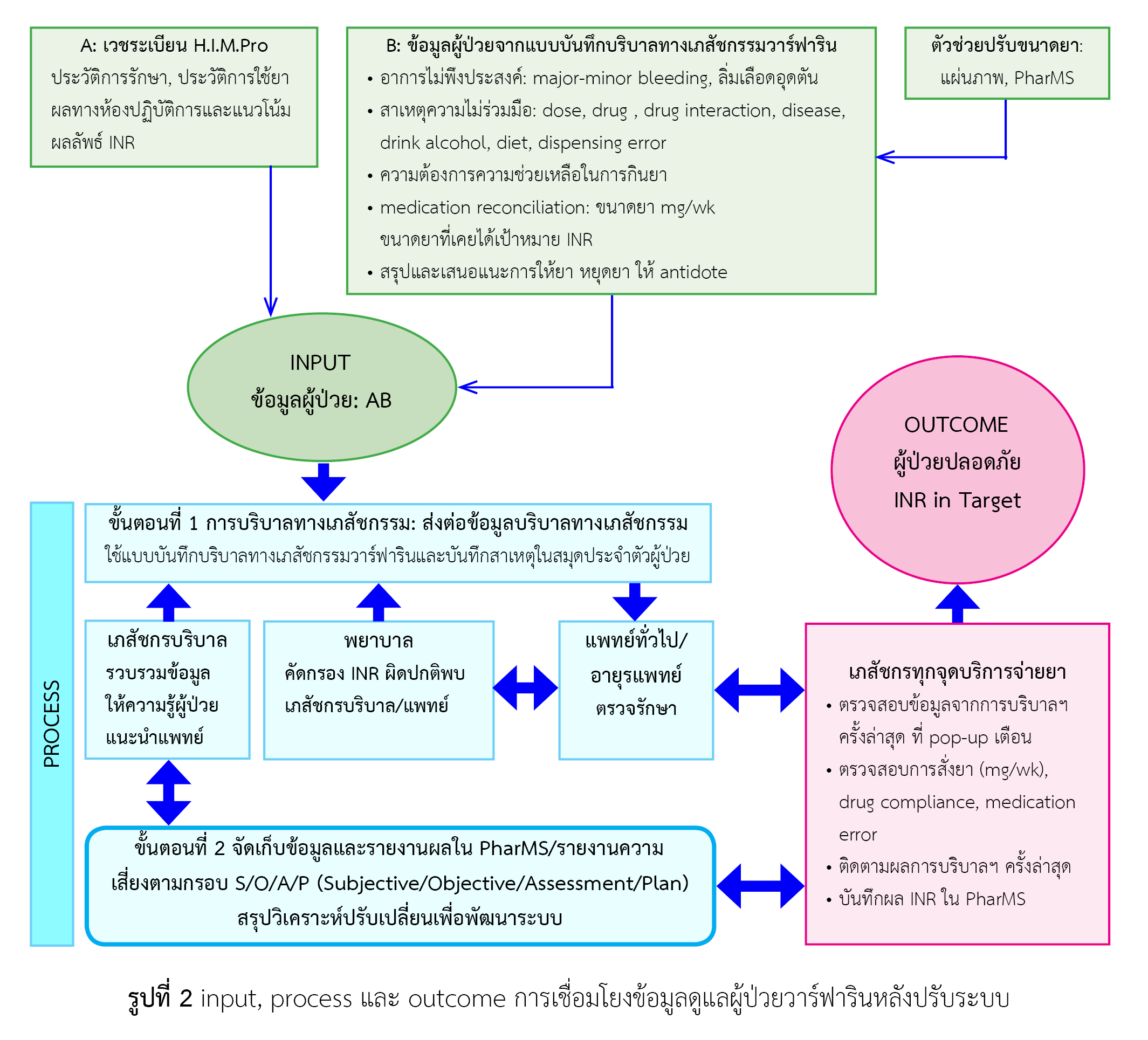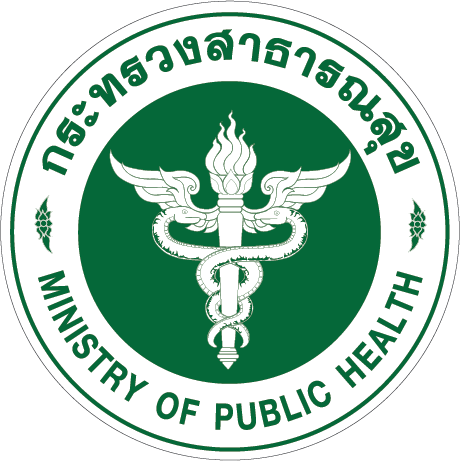Development of a Pharmaceutical Care Information Referral System for Warfarin Patients
Keywords:
warfarin, information technology, drug safetyAbstract
Background: Treatment outcomes and adverse reactions can be monitored by pharmaceutical care data transferring and systematic problem solving. Kantharalak Hospital developed a system for transferring pharmaceutical information of warfarin users by using S/O/A/P in information technology.
Objectives: To develop a system for transferring pharmaceutical information to warfarin users and to assess treatment outcomes and drug safety both before and after system development.
Methods: This action research consisted of 4 phases: phase 1 preparation, phase 2 implementation, phase 3 observation and data collection, and phase 4 reflection and conducted in the fiscal year 2020-2022. Sample group were all patients with at least two hospital warfarin prescriptions each fiscal year. Data were analyzed by descriptive statistics and independent t-test.
Results: The development of systematic data storage and transferring model provided continuity in the pharmaceutical care process, the data collecting and reporting were more convenient. The proportion of the total warfarin patients who achieved the target INR level (INR 2.0 – 3.0) was 54.3%, 55.6%, and 55.5%, respectively in the fiscal year 2020, 2021, and 2022. The percentage of times which each patient achieved the target INR in the fiscal year 2022 significantly decreased from 2020 and 2021, p = 0.020 and 0.003 respectively. Those receiving pharmaceutical care achieved the target INR level of 73.5% in 2021 and raised to 76.1% in 2022. Regarding drug safety, the cause of the outside target INR occurred 96.0% in 2021 and decreased to 72.3% in 2022. It was found that between 2020 and 2022, the risk in the drug system tended to decrease. The minor and preventable risk level A, B, and C was found 31, 20, and 26 times, respectively. The serious and dangerous risks level D, E was found 12, 8, and 1 times respectively.
Conclusion: The development of a pharmaceutical care information transfer system for warfarin patients could support patient care, improve treatment outcomes, and increase patient safety.
References
สถาพร มณี, นุชกานดา มณี. ผลลัพธ์การพัฒนาระบบเทคโนโลยีสารสนเทศสำหรับบริหารจัดการคลินิกวาร์ฟาริน. พุทธชินราชเวชสาร [อินเทอร์เน็ต]. 2560 [สืบค้นเมื่อ 1 มกราคม 2565];34(3):371-81. สืบค้นจาก: https://he01.tci-thaijo.org/index.php/BMJ/article/view/122929
เจนจิรา ตันติวิชญวานิช, โพยม วงศ์ภูวรักษ์, วิบุล วงศ์ภูวรักษ์. การพัฒนาซอฟต์แวร์สาธิตเพื่อการดูแลผู้ป่วยที่ใช้วาร์ฟารินในโรงพยาบาลปัตตานี. วารสารเภสัชกรรมไทย [อินเทอร์เน็ต]. 2558 [สืบค้นเมื่อ 1 มกราคม 2565];7(2):288-304 สืบค้นจาก: https://he01.tci-thaijo.org/index.php/TJPP/article/view/169652
สุภารัตน์ พัฒนสมบัติ, อุไรวรรณ ตระการกิจวิชิต, อุทัยวรรณ เมืองแมน, ณัฐวัฒน์ กังวานศิรวัธน์, ธงชัย วัลลภวรกิจ, นุชน้อยประภาโส, และคณะ, บรรณาธิการ. แนวทางการจัดการด้านยาใน Service Plan สาขาโรคหัวใจและสาขาโรคไต. กองบริหารการสาธารณสุข สำนักงานปลัดกระทรวงสาธารณสุข. สมุทรสาคร: บอร์นทูบีพัพลิชชิ่ง; 2563.
ภูขวัญ อรุณมานะกุล, สุรกิจ นาทีสุวรรณ, บรรณาธิการ. แนวทางการบริบาลเภสัชกรรมในผู้ป่วยที่ได้รับยาต้านการแข็งตัวของเลือด. กรุงเทพฯ: สมาคมเภสัชกรรมโรงพยาบาล (ประเทศไทย); 2559.
พรชัย วีระเศรษฐ์ศิริ. ประเมินการใช้ trigger tool ในผู้ป่วยในที่ได้รับยา warfarin ของโรงพยาบาลราชบุรี. วารสารองค์การเภสัชกรรม [อินเทอร์เน็ต]. 2559 [สืบค้นเมื่อ 1 มกราคม 2565];43(1):34-44. สืบค้นจาก: https://www2.gpo.or.th/LinkClick.aspx?fileticket=nLvV5dTQX1w%3D&tabid=111&mid=599
Connolly SJ, Pogue J, Eikelboom J, Flaker G, Commerford P, Franzosi MG, et al. Benefit of oral anticoagulant over antiplatelet therapy in atrial fibrillation depends on the quality of international normalized ratio control achieved by centers and countries as measured by time in therapeutic range. Circulation. 2008;118(20):2029-37. doi: 10.1161/CIRCULATIONAHA.107.750000.
ประยุทธ ภูวรัตนาวิวิธ, ปวีณา สนธิสมบัติ, อิศราวรรณ ศกุนรักษ์, ขวัญชัย รัตนมณี, ระพีพล กุญชร ณ อยุธยา, ชาคริต หริมพานิช, และคณะ. ปฏิกิริยาระหว่างอาหารกับ warfarin: ข้อเท็จจริงกับความเชื่อ. วารสารเภสัชกรรมไทย [อินเทอร์เน็ต]. 2565 [สืบค้นเมื่อ 1 ตุลาคม 2565];14(3):1-10. สืบค้นจาก: https://he01.tci-thaijo.org/index.php/TJPP/article/view/249934
สกนวรรณ พวงหอม, อรอนงค์ หงส์ชุมแพ, ศรีษา แซ่เนี้ยว. การพัฒนาแบบบันทึกปัญหาเนื่องจากการใช้ยาและคำแนะนำการปรับขนาดยาในผู้ป่วยใช้วาร์ฟาริน. วารสารหัวหินสุขใจไกลกังวล [อินเทอร์เน็ต]. 2559 [สืบค้นเมื่อ 1 มกราคม 2565];1(1):74-84. สืบค้นจาก: https://he01.tci-thaijo.org/index.php/hhsk/article/view/175020
สมาคมแพทย์โรคหัวใจแห่งประเทศไทยในพระบรมราชูปถัมภ์. แนวทางการรักษาผู้ป่วยด้วยยาต้านการแข็งตัวของเลือดชนิดรับประทาน พ.ศ.2553. พิมพ์ครั้งที่ 1. กรุงเทพมหานคร: สำนักงานหลักประกันสุขภาพแห่งชาติ; หน้า 21-6.
Priksri W, Rattanavipanon W, Saejear W, Tanyasaensook K, Phrommintikul A, Chulavatnatol S, et al. Incidence, risk factors, and outcomes of warfarin-associated major bleeding in Thai population. Pharmacoepidemiol Drug Saf. 2019;28(7):942-950. doi: 10.1002/pds.4781.

Downloads
Published
How to Cite
Issue
Section
License
Copyright (c) 2023 Health Administration Division, Office of the Permanent Secretary, Ministry of Public Health and The Society of Hospital Pharmacist, Ministry of Public Health

This work is licensed under a Creative Commons Attribution-NonCommercial-NoDerivatives 4.0 International License.
ข้อความภายในบทความที่ตีพิมพ์ในวารสารเภสัชกรรมคลินิกทั้งหมด รวมถึงรูปภาพประกอบ ตาราง เป็นลิขสิทธิ์ของกองบริหารการสาธารณสุข สำนักงานปลัดกระทรวงสาธารณสุข และ ชมรมเภสัชกรโรงพยาบาลกระทรวงสาธารณสุข การนำเนื้อหา ข้อความหรือข้อคิดเห็น รูปภาพ ตาราง ของบทความไปจัดพิมพ์เผยแพร่ในรูปแบบต่าง ๆ เพื่อใช้ประโยชน์ในเชิงพาณิชย์ ต้องได้รับอนุญาตจากกองบรรณาธิการวารสารเภสัชกรรมคลินิกอย่างเป็นลายลักษณ์อักษร
กองบริหารการสาธารณสุข สำนักงานปลัดกระทรวงสาธารณสุข และ ชมรมเภสัชกรโรงพยาบาลกระทรวงสาธารณสุข อนุญาตให้สามารถนำไฟล์บทความไปใช้ประโยชน์และเผยแพร่ต่อได้ โดยอยู่ภายใต้เงื่อนไขสัญญาอนุญาตครีเอทีฟคอมมอน (Creative Commons License: CC) โดย ต้องแสดงที่มาจากวารสาร – ไม่ใช้เพื่อการค้า – ห้ามแก้ไขดัดแปลง, Attribution-NonCommercial-NoDerivatives 4.0 International (CC BY-NC-ND 4.0)
ข้อความที่ปรากฏในบทความในวารสารเป็นความคิดเห็นส่วนตัวของผู้เขียนแต่ละท่านไม่เกี่ยวข้องกับกองบริหารการสาธารณสุข สำนักงานปลัดกระทรวงสาธารณสุข และ ชมรมเภสัชกรโรงพยาบาลกระทรวงสาธารณสุข และบุคลากรในกองฯ หรือ ชมรมฯ แต่อย่างใด ความรับผิดชอบองค์ประกอบทั้งหมดของบทความแต่ละเรื่องเป็นของผู้เขียนแต่ละท่าน หากมีความผิดพลาดใด ๆ ผู้เขียนแต่ละท่านจะรับผิดชอบบทความของตนเอง ตลอดจนความรับผิดชอบด้านเนื้อหาและการตรวจร่างบทความเป็นของผู้เขียน ไม่เกี่ยวข้องกับกองบรรณาธิการ



